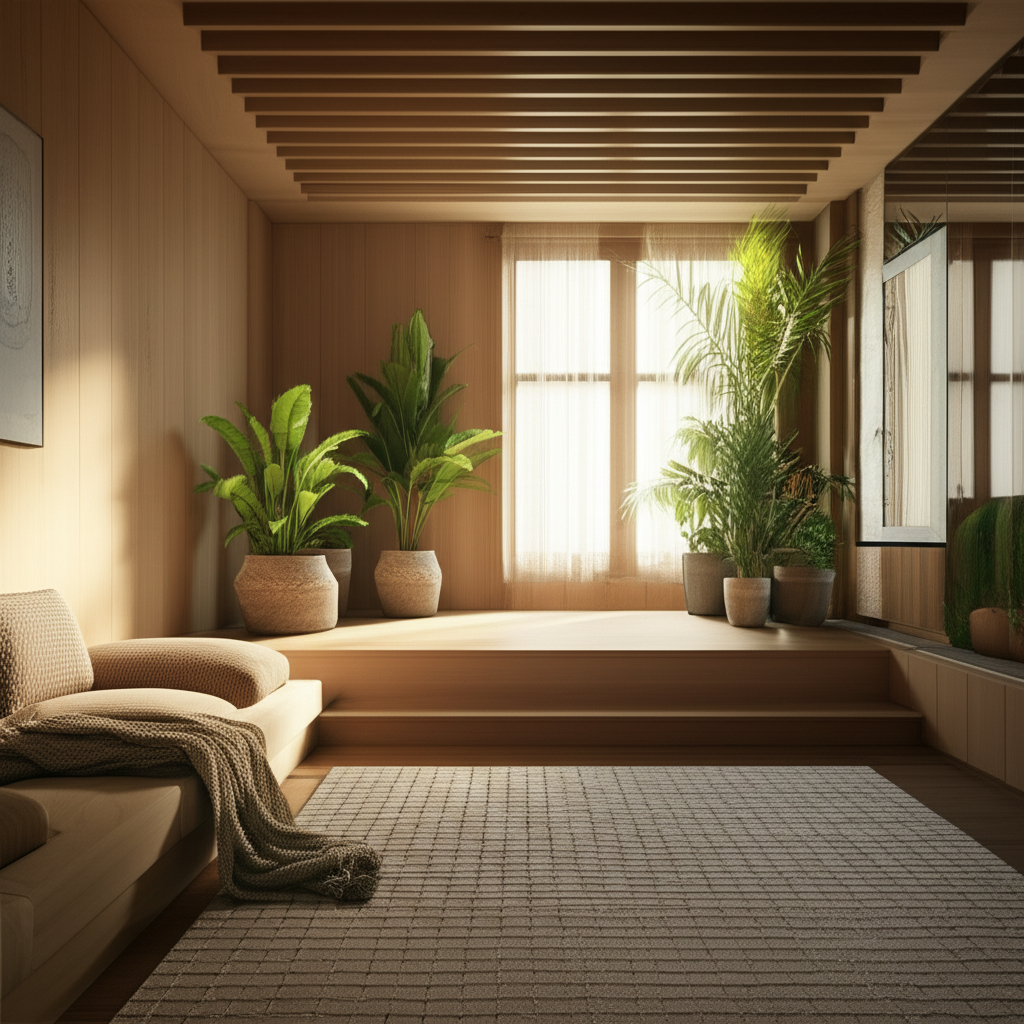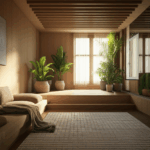Now Reading: Create a Calming Home: Design for Mental Peace
-
01
Create a Calming Home: Design for Mental Peace
Create a Calming Home: Design for Mental Peace

Life can often feel like a whirlwind, can’t it, dear friend? In our fast-paced world, it’s incredibly easy to feel overwhelmed, stressed, and constantly on edge. But what if your home – the very place you seek solace and comfort – could become your most powerful, silent ally in fostering true mental peace? It truly can, and that’s precisely the heartwarming journey we’re here to embark on together today. Let’s begin to think of your living space not just as walls and furniture, but as a supportive, nurturing partner in your personal well-being journey.
The truth is, our physical environment holds a profound and often underestimated impact on our mental and emotional health. From the moment we open our eyes to the moment we gently drift to sleep, our surroundings subtly influence our mood, our stress levels, and our overall sense of calm. The wonderful news? Through thoughtful, intentional design choices, you have the power to transform your home into a genuine sanctuary—a peaceful retreat that nurtures your mind, body, and soul. Creating a calming home environment isn’t merely about aesthetics; it’s a deeply accessible form of self-care, a continuous act of kindness towards yourself, helping you gracefully reduce stress and foster deep resilience.
The Foundation of Calm: Decluttering & Organization
Why Clutter Equals Stress
Ever walked into a cluttered room and instantly felt your shoulders tense, dear one? You are absolutely not alone. There’s a powerful, well-established psychological link between disorganization and increased feelings of stress, anxiety, and even difficulty focusing. When our physical environment is chaotic, our minds often, quite naturally, mirror that chaos. Research even suggests that visual clutter can overstimulate our brains, potentially leading to elevated cortisol levels (our body’s stress hormone) and a persistent feeling of being constantly overwhelmed. It subtly drains our mental energy, making it so much harder to relax and find precious clarity.
Practical Decluttering Strategies
The idea of decluttering can feel incredibly daunting, can’t it? It’s easy to feel overwhelmed before you even begin. But remember, dear friend, this isn’t about achieving perfection overnight; it’s about making gentle, consistent progress. Let’s tackle it together, with kindness and understanding, just like a trusted friend guiding you through a comforting conversation:
- Start Small, Celebrate Often: Don’t feel pressured to declutter your entire home in one go. That’s a recipe for burnout! Instead, pick one small, manageable area – perhaps a single drawer, a shelf, or just your nightstand. The satisfaction of completing a small task can be incredibly motivating, building momentum for your next step.
- The “Four-Box Method” for Clarity: Grab four boxes (or even just designated piles!). Label them: “Keep,” “Donate/Sell,” “Trash/Recycle,” and “Relocate” (for items that belong in another room). As you go through items, assign each one to a box. This method provides clear categories and helps you process decisions efficiently.
- The “Does it Spark Joy?” Principle (or “Useful/Loved”): Hold each item. Take a moment. Does it genuinely bring you happiness? Is it truly useful in your daily life? If the answer is a gentle ‘no’ to both, then it’s okay to thank it for its service and mindfully let it go. This isn’t about harsh judgment, but about thoughtful curation of the items that truly serve you.
- Implement the “One-In, One-Out” Rule: To prevent clutter from creeping back in, adopt this simple yet powerful habit. For every new item you bring into your home (a new shirt, a new book, a new kitchen gadget), commit to letting go of an existing item in that same category. It’s a fantastic way to maintain balance.
- Create a “Home” for Everything: Once you’ve decided what to keep, ensure every single item has a designated spot. When putting things away becomes second nature, you significantly reduce visual noise and make tidying up much, much easier. Imagine the calm of knowing exactly where everything belongs!
- Regular Maintenance is Key: Dedicate a short, consistent block of time each day – even just 10-15 minutes – to tidying up. A quick evening sweep before bed can make an enormous difference in how you feel waking up in the morning, setting a peaceful tone for the new day.
Thoughtful Storage Solutions
Once you’ve lovingly decluttered, smart and practical storage becomes your best friend in maintaining that newfound calm. Think creatively with shelves, beautiful woven baskets, and cleverly hidden compartments. These aren’t just practical solutions; they beautifully reduce visual clutter, fostering a sense of order and peace that truly allows your mind to relax. Even in a smaller apartment, creative vertical storage can work absolute wonders, dear one!
Harnessing the Power of Color & Light
Calming Color Palettes for Mental Peace
Colors profoundly affect our mood, often without us even realizing their gentle influence. To create a truly serene space, lean into palettes that naturally soothe your soul and invite tranquility:
- Blues and Greens: These colors are deeply associated with nature—the calming ocean, lush forests, a serene sky. They’ve been beautifully shown to reduce stress, gently lower heart rates, and promote a profound sense of serenity and peace. Think soft sky blues, gentle sage greens, or deep teals that remind you of still waters.
- Warm Neutrals: Creams, soft grays, gentle beiges, and muted browns provide a grounded, wonderfully welcoming feel. They offer a sense of stability and warmth, creating a cozy environment that feels like a comforting, gentle embrace.
- Avoiding Overstimulating Colors: In your key relaxation zones like bedrooms or living rooms, it’s often wise to avoid overly bright, highly saturated reds or yellows. While vibrant, these can sometimes be stimulating and might increase anxiety for some individuals. Save those cheerful pops of color for accent pieces in more active, energetic areas of your home.
Optimizing Natural Light
Natural light is a powerful mood booster and truly a cornerstone of home design for mental health. Maximizing it can significantly improve your mood, gently regulate your circadian rhythms, and even enhance the quality of your precious sleep. Keep your windows clear of heavy drapery, opting instead for light-filtering blinds or sheer curtains, and thoughtfully position furniture to allow light to flow freely and unhindered. If you’re in a smaller space or a rental, strategically placed mirrors can be magical, helping to bounce natural light around the room, making it feel brighter, more expansive, and utterly welcoming.
Creating Ambient Artificial Lighting
When natural light gracefully fades, artificial lighting steps in, but its quality matters immensely, dear one. Harsh, bright overhead lights can be jarring and, surprisingly, increase stress. Instead, opt for warm, soft, dimmable lighting from multiple sources. Think cozy table lamps, elegant floor lamps, and even whimsical fairy lights. Strategic placement of lamps at different heights creates beautiful layers of light, mimicking the gentle glow of twilight and helping to lower cortisol, making your space feel incredibly cozy, inviting, and truly peaceful. This thoughtful sensory design encourages deep relaxation and a gentle winding down at the end of your day.
Bringing Nature Indoors: Plants & Natural Elements
The Mental Health Benefits of Houseplants
Inviting nature indoors is such a beautiful and nurturing way to enhance your mental well-being. Houseplants aren’t just decorative; they actively improve air quality, gently reduce stress, wonderfully boost mood, and can even enhance your focus. Caring for a living plant can become a simple, grounding self-care ritual in itself, connecting you to something vibrant and alive. Here are some specific calming plant companions:
- Peace Lily: Elegant and renowned for its air-purifying qualities.
- Lavender: Famous for its incredibly soothing scent (though often grown outdoors, some varieties can thrive indoors in bright spots).
- Snake Plant: Incredibly low-maintenance and an excellent natural air purifier.
- Rosemary: Offers an invigorating, clarifying scent, and can be grown in a sunny spot.
- Jasmine: Possesses a beautiful, delicate scent, making it ideal for a tranquil bedroom.
- Aloe Vera: A practical plant with wonderful medicinal properties, and so easy to care for.
For beginners or those with busy lives, low-maintenance options like snake plants, ZZ plants, or Pothos are fantastic, forgiving choices to lovingly start with.
Incorporating Natural Materials & Textures
Beyond the living beauty of plants, integrating natural materials and textures can profoundly impact your emotional well-being. Think warm wood, cool stone, soft cotton, crisp linen, and comforting wool. These elements bring an organic, grounding, and deeply comforting feel to your space. The tactile experience of a rough wooden table, a soft linen throw, or a chunky knit blanket gently connects us to the natural world, promoting a sense of ease and relaxation. Consider incorporating nature-inspired artwork, too – serene landscapes or delicate botanical prints can beautifully evoke a sense of calm and tranquility.
Engaging the Senses: Sound, Scent, & Touch
Cultivating a Soothing Soundscape
Our homes are often filled with sounds, dear one, but are they soothing or distracting? Cultivating a peaceful soundscape involves thoughtfully minimizing unwanted noise and gently introducing calming sounds. Soft furnishings like plush rugs, heavy curtains, and upholstered furniture can beautifully absorb sound, reducing echoes and external disturbances. Consider introducing gentle, restorative sounds like soft instrumental music, nature sounds (the gentle patter of rain, the rhythmic rush of ocean waves, or a tranquil waterfall), or even comforting white noise to mask urban sounds and create a quiet zone perfect for focus or deep rest.
Aromatherapy for Relaxation
Our sense of smell is incredibly powerful, directly linked to our deepest emotions and cherished memories. Aromatherapy is an accessible, delightful self-care technique that uses the magic of scents to promote profound relaxation. Experiment with essential oil diffusers, high-quality, natural candles, or even fresh herbs like invigorating mint or fragrant basil. Calming scents like lavender (wonderful for sleep and anxiety relief), chamomile (deeply soothing), eucalyptus (clarity and freshness), rosemary (focus and revitalization), and jasmine (uplifting yet wonderfully calming) can truly transform the atmosphere of your home, creating a serene space that beautifully promotes mental peace.
Comforting Textures & Soft Furnishings
Physical comfort is paramount for promoting deep relaxation. Oh, to wrap yourself in a world of softness! Plush rugs underfoot, irresistibly cozy blankets draped over sofas, and an abundance of soft throw pillows invite you to sink in and unwind completely. These comforting textures contribute beautifully to the “Hygge” philosophy (which we’ll explore shortly) and make your home feel like a true sanctuary, gently reducing overwhelm and fostering a profound sense of warmth, security, and belonging.
Creating Intentional Zones & Personal Retreats
Designating Spaces for Different Activities
In today’s multi-functional homes, it’s truly vital to create intentional zones for different activities, especially if you’re navigating a smaller living situation or shared spaces. Designate a specific spot for pure relaxation—perhaps a comfortable armchair by a sunlit window for reading, a small meditation corner with a soft cushion, or a dedicated spot for thoughtful journaling. Critically, create tech-free zones, especially in bedrooms, to lovingly protect your sleep and mental peace from digital distractions. Setting clear, gentle boundaries between work and rest areas, even if it’s just a different side of the same room, can significantly reduce mental fatigue and beautifully improve your ability to unwind and recharge.
Personalizing Your Space
Your home, dear friend, should feel unmistakably like *you*. Surrounding yourself with meaningful objects, cherished artwork, and photos that evoke joy, treasured memories, and a sense of security is absolutely crucial. These personal touches aren’t clutter; they’re precious anchors for your well-being, weaving your story into the fabric of your home. The importance of feeling safe, comfortable, and truly at home in your own space cannot be overstated. It’s where you recharge, reflect, and simply *be*—your authentic self, without apology.
Incorporating Holistic Design Philosophies
Hygge: The Art of Cozy Well-being
Hygge (pronounced “hoo-gah”) is a cherished Danish concept deeply rooted in the art of cozy well-being. It’s not just about aesthetics but about consciously creating an atmosphere of warmth, comfort, togetherness, and presence—savoring the simple joys. To lovingly apply Hygge elements:
- Low Lighting: Embrace the gentle glow of candlelight, dim lamps, and the warm flicker of a fireplace (real or virtual).
- Soft Blankets & Pillows: Pile them high and invite irresistible snuggles!
- Earthy Elements: Incorporate the grounding beauty of wood, ceramics, wool, and other natural textures.
- Warm Beverages: Savor a hot cup of tea, coffee, or cocoa, enjoyed slowly and mindfully.
- Cozy Activities: Indulge in reading a good book, engaging in heartfelt chats with loved ones, or playing a board game.
Hygge gently encourages you to slow down, savor each precious moment, and find profound joy in the simple things, fostering a deep sense of belonging and beautifully reducing overwhelm.
Feng Shui: Harmonizing Your Environment
Feng Shui is an ancient Chinese practice focused on harmonizing individuals with their surrounding environment. Its basic principles lovingly aim to optimize the flow of positive energy, or “Chi,” for better health, happiness, and prosperity. While it can be wonderfully complex, here are some accessible tips for cultivating a calming home:
- Declutter: Echoing our earlier advice, clear pathways allow vital energy to flow freely and smoothly.
- Natural Light & Air: Maximize these precious elements for vitality and freshness.
- Specific Colors: Thoughtfully use calming colors (gentle blues, soft greens, soothing neutrals) in your relaxation areas.
- Commanding Positions: Arrange key furniture, like your bed or desk, so you can see the door without being directly in line with it. This provides a subtle yet powerful sense of security and control, which can be incredibly reassuring for your mental peace.
Even small, thoughtful shifts based on these philosophies can contribute significantly to a more balanced, tranquil, and harmonious living space.
Your Sanctuary Awaits: A Gentle Path to Inner Peace
As we gently close our conversation, dear friend, I hope you feel a renewed sense of possibility for your living space. We’ve journeyed through the profound connection between our homes and our minds, discovering how intentional choices can transform a mere dwelling into a true sanctuary for your soul. Remember, it all begins with the courage to declutter gently, making space not just in your home, but in your mind too.
We’ve seen how harnessing the soft embrace of natural light and soothing colors can uplift your spirit, how inviting the serene energy of nature indoors with plants and organic textures can ground you, and how thoughtfully engaging your senses through sound, scent, and touch can create an atmosphere of profound calm. By designating personal retreats and embracing philosophies like Hygge and Feng Shui, you’re not just decorating; you’re nurturing a deeper connection with yourself and your environment.
The beauty of this journey is that every small step you take, every thoughtful decision you make – whether it’s clearing a cluttered countertop, adding a cozy blanket, or simply opening your curtains wider – contributes significantly to your overall well-being. Your home is more than just a place; it’s a reflection of your inner world and a powerful tool for self-care, helping you reduce stress, enhance focus, and cultivate resilience against life’s inevitable challenges.
So, take a deep breath. There’s no pressure to transform everything overnight. Start with one gentle change, one area that calls to you. Treat yourself and your space with the same kindness and compassion you would offer a cherished friend. Your home truly can become that steadfast, supportive partner in your quest for mental peace, a constant source of comfort where you can authentically breathe, relax, and simply *be*.
I truly believe in your ability to create a space that uplifts and nourishes you. What’s one step you feel ready to take today? Or perhaps you have a calming tip that works wonders for you? I’d absolutely love to hear your thoughts and experiences in the comments below – let’s share our journeys to more peaceful homes together!



















